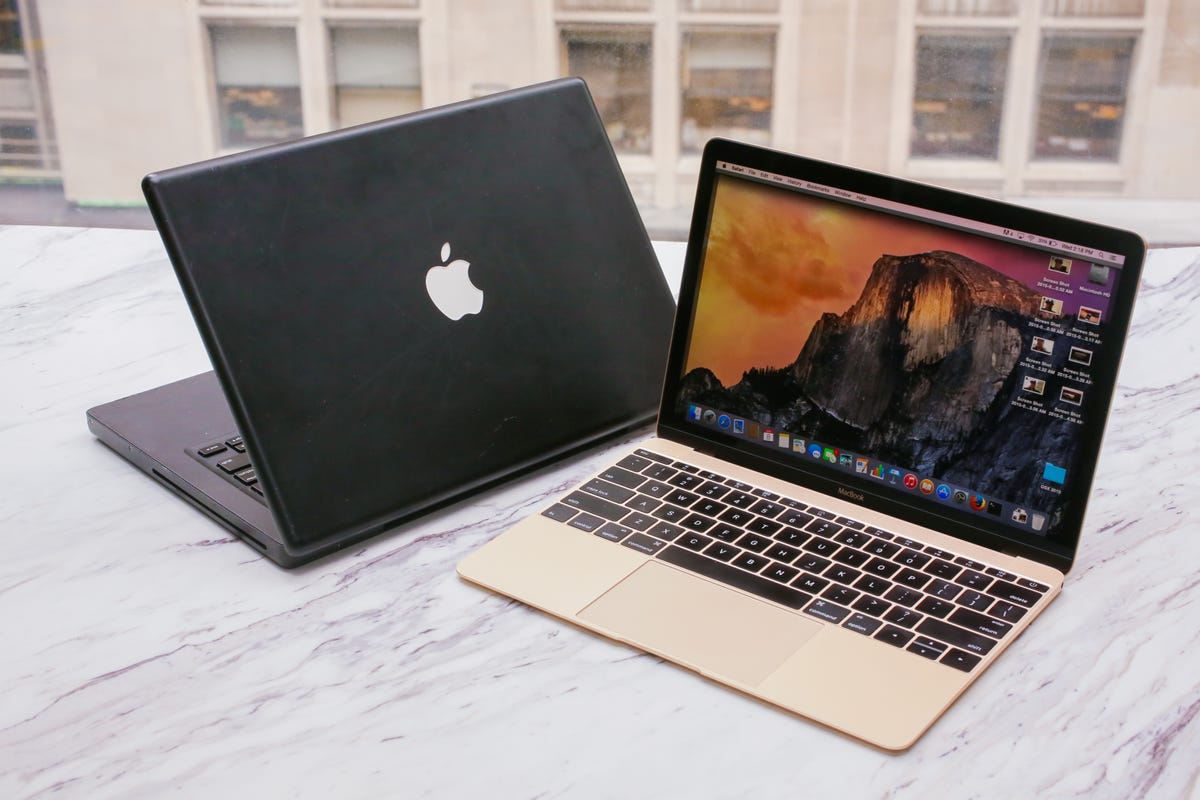
Apple MacBook: Then and now
In May 2006, Apple somewhat quietly replaced the 12-inch PowerBook and 12- and 14-inch iBook models -- the company's entry-level laptops at the time -- with the first 13.3-inch MacBook. Available in white or black (if you were willing to pay a premium), it was the final piece of Apple's transition from PowerPC processors to Intel's CPUs in its laptops and followed the 15- and 17-inch MacBook Pro introductions from earlier that year.
The MacBook went through a handful of other transitions until it was quietly discontinued in 2011, only to return as a wholly different line this year as the new MacBook. Here's how it went from being the budget-friendly Apple laptop for everyone to a showcase for innovative features and design.
MacBook (Intel Core Duo, early 2006)
This is where it all started. Encased in polycarbonate, the MacBook ditched the PowerPC components of its iBook predecessors in favor of Intel-based systems. The base model came in at $1,099 and featured a 13.3-inch, 1,280x800-resolution, glossy, widescreen display; a 1.83GHz Intel Core Duo processor; 512MB of 667MHz DDR2 SDRAM that could be upgraded to 2GB; a 60GB 5,400rpm SATA hard drive; integrated Intel GMA 950 graphics and a slot-load Combo (DVD-ROM/CD-RW) optical drive.
The switch also brought a change from the iBook's Mini-VGA out in favor of a Mini-DVI out with backward compatibility through adapters. Gone, too, was the old pin-style power connector in favor of Apple's MagSafe power adapter. Gigabit Ethernet, two USB 2.0 ports and one FireWire 400 port as well as separate audio-in and audio-out jacks were standard.
For $1,299 you could get it configured with a 2.0GHz Intel Core Duo and a slot-load SuperDrive (DVD±RW/CD-RW) optical drive. Ponying up an additional $200 got you the black version and an additional 20GB of storage space.
In November 2006, these models would be refreshed with Intel Core 2 Duo processors and larger amounts of storage and system memory for the base configurations.
MacBook Air (Intel Core 2 Duo, early 2008)
Though the Air would eventually push the MacBook out as the entry-level laptop in the family, it started its life as a $1,799 premium ultraportable when it arrived in January 2008. The "world’s thinnest notebook" at the time, the Air still boasted a 13.3-inch, 1,280x800-resolution, glossy widescreen display and a full-size keyboard and trackpad.
Featuring a specially-designed 1.6GHz Intel Core 2 Duo processor, 2GB of 667MHz DDR2 memory, integrated graphics and an 80GB hard drive, the Air was about mobility and getting work done, not bang-for-your-buck performance.
The thinness also required some connection elimination: it had only a Micro-DVI port, one USB 2.0 port, a headphone jack and a MagSafe power input.
MacBook (Intel Core 2 Duo, aluminum unibody, late 2008)
Apple overhauled the MacBook family in October 2008, introducing two things that would become staples for its laptops: aluminum unibody design and large, glass multitouch trackpads.
Meant to deliver MacBook Pro design and performance at a lower price point, the base 13.3-inch aluminum MacBook used a 2.0GHz Intel Core 2 Duo processor, 2GB of memory, an Nvidia GeForce 9400M integrated graphics chip and a 160GB 5,400rpm hard drive.
Apple switched to Mini DisplayPort for video output on this model and kicked FireWire 400 to the curb.
A lower-end white polycarbonate MacBook stayed in the line (with FireWire 400), but it was the end of the road for the black polycarbonate model.
MacBook Pro (13-inch aluminum unibody, early 2009)
Apple moved the aluminum unibody 13-inch MacBook up to the Pro class in June 2009. Announcing the switch at its Worldwide Developers Conference, the 13-inch Pro was very similar to the late 2008 MacBook, but with a slightly faster processor, a FireWire 800 port and the new built-in battery introduced on the 17-inch MacBook Pro in January 2009.
MacBook (13-inch polycarbonate unibody, late 2009)
Like the 13-inch MacBook Pro, the MacBook announced in October 2009 had unibody design, but this time it was made from polycarbonate instead of aluminum. It made the enclosure lighter and more durable, but was less expensive than aluminum.
The MacBook also lacked the SD card slot and FireWire 800 port of the 13-inch Pro, but, for better or worse, had the user non-replaceable built-in battery.
MacBook Air (11-inch, mid 2011)
The 13-inch MacBook remained in the family with the Pro and the Air until it was discontinued in July 2011. It was replaced by the $999 11-inch Air with 1.6GHz Intel Core i5 processor backed by 2GB of memory and 64GB of flash storage.
By this point, Apple had added a second USB 2.0 port and replaced the Mini DisplayPort with one that had Thunderbolt capabilities.
MacBook (12-inch, early 2015)
The MacBook returned in 2015, though it has more in common with the original MacBook Air than its origins as an entry point for Apple's laptop line.
Weighing in at just 2 pounds and measuring 13.1 millimeters thick, it is the thinnest, lightest Mac to date. It's the first that's completely fanless, too, so it runs silent, and it has a high-resolution Retina screen. This is also the first MacBook with a USB-C port and, outside of a headphone jack, it's the only port on the thing, used for everything from connecting to an external display to attaching a hard drive to charging its battery.
It's definitely a break from the past and a look at the future. Read our full review for more details.


